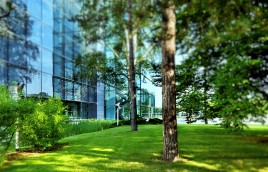Will Municipalities Run With Environmental License?
 Blog Entry | July 21, 2015
Blog Entry | July 21, 2015Will Municipalities Run With Environmental License?
I was lucky enough to have attended the recent Climate Summit of the Americas in Toronto. Beyond the excitement of experiencing the visions of several Premiers and Governors, it was a very powerful and empowering experience.
Over the past week, I’ve been trying to process any lessons learned, and here’s what I’ve concluded.
It seems odd to me that the sub-national play- the reliance on sub-nationals to take more active roles in designing climate change strategies- has taken this long to arguably take hold in the international community. While I’m not sure what the catalyst to this sub-national role was, it clearly works in the absence of national governments’ leadership. Insert understatement here…
Provinces are clearly the jurisdictions to regulate GHGs as they regulate and contract for power generation and generate the GHG caps for industries. In my opinion, the Alberta oil sands were the catalyst for federal government to hem and haw in order to devise ways of protecting its interests of bringing oil to international markets, unhindered. Otherwise, we may have been much further ahead with a federal government quarterbacking the provinces. But no.
While BC, Quebec and Ontario are now leading the way in the overall GHG reductions for Canada, we need to look beyond and determine how we get greater reductions and where??? Meeting the current GHG targets is about demonstrating the approach and pathway to generate reductions, but jurisdictions can lead far beyond that.
Municipalities account for approximately 85% of all infrastructure in Canada, and while municipalities are creatures of their provinces, municipalities have the abilities to actually generate the GHG reductions in their buildings, their transportation and transit systems, and their green lands.
Municipalities have the ability to not only reduce their own GHG within their operations, but have the ability to drive better planning processes and with better tax classifications to drive greater adoption of private facilities being more energy efficient.
The design of roads, transit, parks, employments zones, schools, and housing all have very specific impacts on the GHG intensity level of communities. The same swath of land could require vehicles to get to the closest grocery store, or it could be a community of live work and play, where walking, biking, transit and neighborhood stores are part of the fabric and not a nuisance in the way of road travel…
While some municipalities have always chosen to lead ahead of provincial direction, this Climate Summit definitely granted an environmental license to municipalities to create the communities that are truly sustainable.
Will municipalities take this environmental license? In my experience, municipalities require the same vigor and vision that you find in successful businesses. Yes, I know, a municipality is not a business, but it competes every day for people, jobs and culture. Its success is based on who and what it wants to attract and sets very specific targets to achieve it. I have seen plenty a municipality have an appetite to change its ways in order to attract people and jobs, but stops short of differentiating itself from neighbouring municipalities.
Too many municipalities accept the conditions they find themselves in, like small amount of serviced employment lands, road-based communities, and empty manufacturing plants. Many will try same old tactics to generate growth without changing the DNA of what they want to look like as a municipality.
I’ve also seen cities adopt great direction but for argument sake, is not the desired direction of the current voters. It’s not a bad thing. But you need to work harder to communicate with them to educate them as to what’s needed and why and for who. I’ve seen residents who have moved to the suburbs to buy a larger lower cost home, and yet complain when an LRT is being considered nearby to bring residents to subway lines quicker. They would rather not ruin the road by removing the lane of cars. There is something wrong here, and it fundamentally comes down to the municipality is building a city for residents it wants vs the ones it has. Good luck. Not an easy challenge, but it definitely starts with educating and maybe show them how their property values go up with the changes….
In my opinion, the municipality that develops a sustainable community with sustainable infrastructure will sustain the right jobs and people who will drive growth going forward. Municipal leaders, rise up and take that environmental license and declare you are going to be the greenest and most innovative community in North America and don’t look back. You blink, you lose.
For every other municipal leader, take your position in line of the laggards and you’ll be kicking and screaming as to the eventual environmental requirements, but at least you’ll have the best buggy whips in town…. for a while.
There are clear approaches and strategies and tactics that can generate a leading municipality, and I look forward to continuing those conversations with municipal leaders.
If you have any thoughts, don’t hesitate to share on social media or email me.
Thank you,
Frank Carnevale
Thought leader on sustainability, energy efficiency and clean energy
[email protected]
Twitter @fcarnevale and @sustainco
